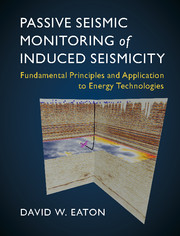 Passive Seismic Monitoring of Induced Seismicity
Passive Seismic Monitoring of Induced Seismicity Book contents
- Frontmatter
- Contents
- Preface
- List of Symbols
- Part I Fundamentals of Passive Seismic Monitoring
- Part II Applications of Passive Seismic Monitoring
- 5 Passive-Seismic Data Acquisition
- 6 Downhole Microseismic Processing
- 7 Surface and Shallow-Array Microseismic Processing
- 8 Microseismic Interpretation
- 9 Induced Seismicity
- Appendix A Glossary
- Appendix B Signal-Processing Essentials
- Appendix C Data Formats
- References
- Index
5 - Passive-Seismic Data Acquisition
from Part II - Applications of Passive Seismic Monitoring
Published online by Cambridge University Press: 07 June 2018
- Frontmatter
- Contents
- Preface
- List of Symbols
- Part I Fundamentals of Passive Seismic Monitoring
- Part II Applications of Passive Seismic Monitoring
- 5 Passive-Seismic Data Acquisition
- 6 Downhole Microseismic Processing
- 7 Surface and Shallow-Array Microseismic Processing
- 8 Microseismic Interpretation
- 9 Induced Seismicity
- Appendix A Glossary
- Appendix B Signal-Processing Essentials
- Appendix C Data Formats
- References
- Index
Summary
You can observe a lot by watching.
Yogi Berra (John Wiley & Sons, 2008)Passive-seismic monitoring makes use of observations of either naturally occurring seismic signals, or anthropogenic “sources of opportunity,”1 in order to characterize the architecture, properties and dynamic processes that occur within a targeted region in the subsurface. Similar information can be gleaned from active seismic methods, wherein controlled sources, such as buried explosive charges, are used to generate wavefields with precisely known origin time and location. Passive monitoring has the advantage that the effort and expense to deploy seismic sources are avoided, but the disadvantage that precise timing and location of sources are not known a priori.
There are number of practical applications of passive-seismic monitoring. Microseismic monitoring is a key technology in the petroleum industry for surveillance and diagnostic characterization of hydraulic fracturing (Warpinski, 2009; Maxwell et al., 2010; Van der Baan et al., 2013), enhanced-oil recovery (McGillivray, 2005), reservoir characterization (Maxwell and Urbancic, 2001) and casing integrity (Smith et al., 2002). Similar methods are used at a more regional scale for monitoring induced seismicity, with applications in various sectors including the petroleum (Raleigh et al., 1976; Suckale, 2010) and geothermal industries (Majer et al., 2007). Microseismic arrays are also critical for safety protocols in underground mines, where they are widely used to monitor fault activity and rockbursts (Gibowicz and Kijko, 1994). Furthermore, passive-seismic methods based on ambient-noise interferometry have been developed for subsurface imaging (Artman, 2006; Wapenaar and Fokkema, 2006).
The capabilities of an acquisition system to capture the desired components of the seismic wavefield vary with configuration, sensitivity and bandwidth of the installed sensors (Zimmer, 2011; Maxwell, 2014). Seismic events generate signals with different frequency content, depending upon the magnitude of an event; hence, the type of passive-seismic monitoring system that is used depends upon the industrial application and associated seismic signal characteristics. Systems are tailored to record a particular frequency range, covering application-relevant dominant frequencies as shown in Figure 5.1. These systems may be permanent or temporary, and can be classified as follows:
• laboratory acoustic-emission systems;
• microseismic monitoring systems;
• regional short-period seismograph networks;
• broadband seismograph networks;
• long-period global networks.
- Type
- Chapter
- Information
- Passive Seismic Monitoring of Induced SeismicityFundamental Principles and Application to Energy Technologies, pp. 129 - 157Publisher: Cambridge University PressPrint publication year: 2018


